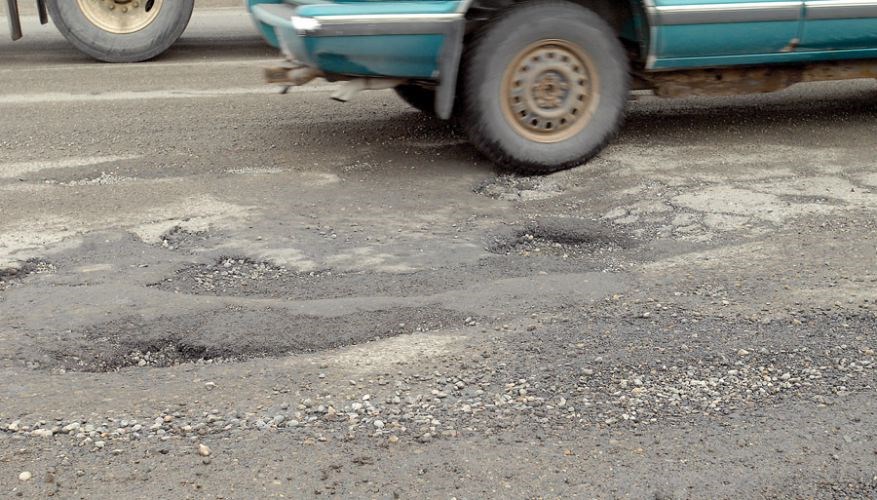When faced with a flat tire (or two) courtesy of your friendly neighbourhood pothole, trying to find a place to lay blame is common for Prince George motorists.
Unfortunately for those looking to have the municipality take responsibility for the auto repair bill, it's uncommon to get a pay out.
The mere presence of potholes in Prince George roads doesn't make the city liable for damage, explained risks and benefits manager Ray Borgia.
"A naturally forming pothole, that we all expect somewhere over the course of our travels during spring freeze-thaw conditions, that's just a fact of life in the north," he said, noting a patched hole may reopen within days due to traffic and weather conditions.
Motorists can file a written notice of claim with the city - the Local Government Act says that must be done within two months from the date the damage happened - but there's a heavy burden of proof.
Potholes, Borgia explained, get treated very specifically compared to other liability claims. Incidents such as a breakdown or malfunction of an asset such as a road or dyke fall under the category of a nuisance claim - there may property damage or injury, but not necessarily evidence of negligence.
"The city [like all B.C. municipalities] has a level of immunity for a nuisance-type claim," said Borgia. "For there to be damage claims from a pothole, which is a malfunction or a breakdown of a road typically, then there needs to be some negligence on the part of the city."
After a notice of claim is submitted, Borgia begins investigating and collects information from the transportation division on complaint and repair reports. He looks for whether the city responded in a reasonable amount of time, which can vary depending on how busy the pothole patch crews are.
Street operations supervisor Mick Jones said there are some roads that just can't be done during the day, but that there are three shifts, which allows them some flexibility in hitting problem areas.
"West Austin's a route that's in need of rehab this year. But it's a two-lane road, it's very busy, it's a hill - it's just difficult to do it on day shifts. We'll do it on the end of afternoon shift or on night shift," Jones said.
He added that roads in the BCR Industrial site are also problematic for daytime patching, due to the volume of traffic and heavy trucks using the roads.
"If you go out to the BCR, we could spend a week out there. But we don't. We don't go out and spend a whole week out there because there's other areas of the city that are falling apart and not getting the attention that they deserve," he said.
Between the regular travels of the city foremen and complaints registered through the city's online and telephone pothole report portals, Jones said they have a pretty good idea of what the streets look like.
"I wouldn't say we get any calls coming in on a day to day basis that require us to respond immediately other than the potential damage-causing potholes," he said. "We know that we've got routes that need attention. It's just a matter of prioritizing."
The department has received upward of 100 calls per day in years past, Jones said, but noted this year hasn't been too notable.
"Last year was bad with Ospika in tough shape, Tabor, 15th - those were some roads that were high volume that were scheduled for rehabilitation but in the spring they were falling apart and we were getting a lot of calls about them," he recalled.
In a perfect world, Jones said, crews would be able to patch one end of a route to the other, but the need to get to potentially damage-causing holes means there's some bouncing around.
"Some people might say 'ah, well you're negligent because you didn't patch it permanently.' There's limitations on what we can do, so that's not really negligence," Borgia said. "The conditions have to be right and you have to have the proper materials for the time of year. Typically during the winter, you don't have good access for hot asphalt."
Some routes are more wet than others due to their location or elevation, Jones added, which reduces the life of the pothole patch.
With a budget of little more than $953,000, a very tiny portion is spent on paying out pothole claims, Borgia said - roughly a few hundred dollars per year.
"Typically five to 10 per cent of pothole claims might result in some sort of payment," he said. "So it's very narrow, what I can pay for, because it has to be based on negligence."
More commonly paid out claims stem from construction work that hasn't been repaired in a timely fashion.
Borgia's decision on whether or not there is an accepted claim to be paid out is final. The only other way to try and get the city to cough up is to take the matter to small claims court.
"I don't think taxpayers want the city to have a big slush fund to pay out claims to everybody who thinks they feel that they've been wronged and should get some money," he said. "Because I can't see how that pool of people out there would ever be satisfied. It would just grow."


.png;w=120;h=80;mode=crop)
